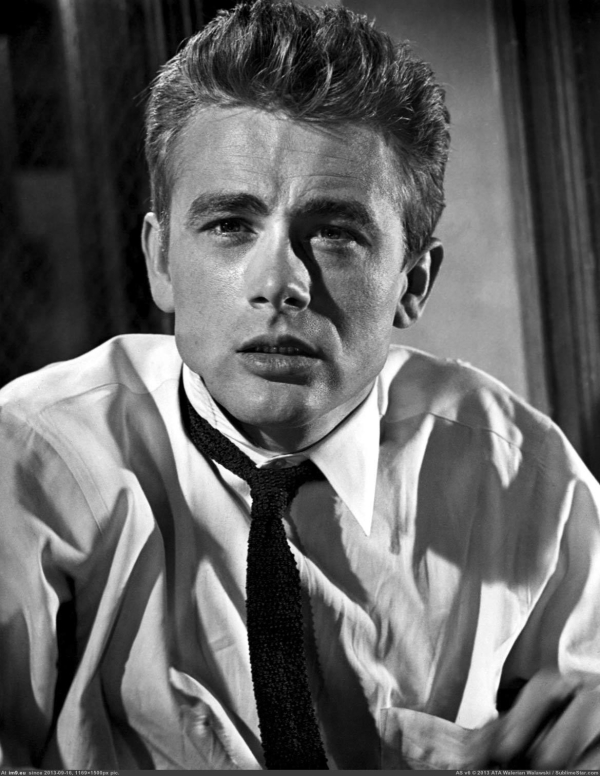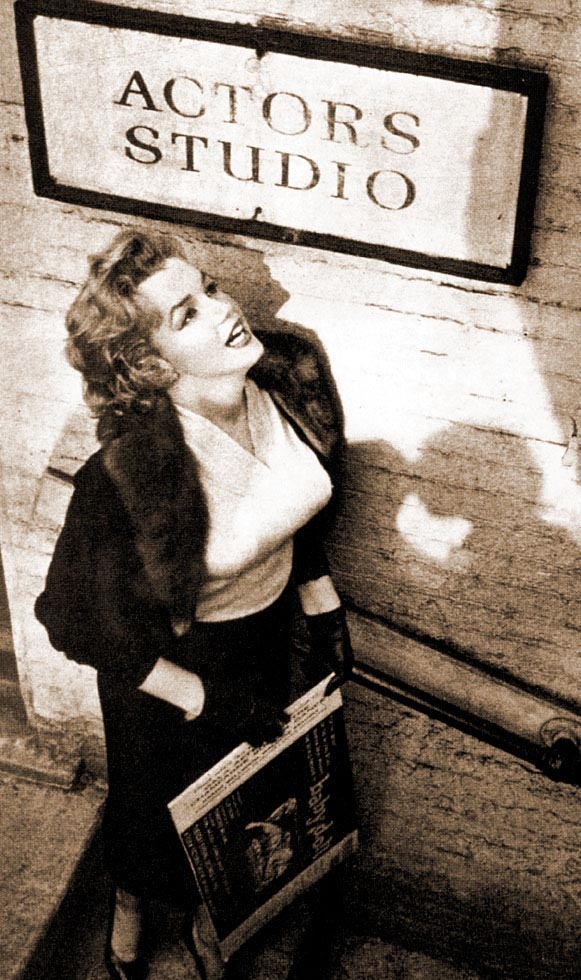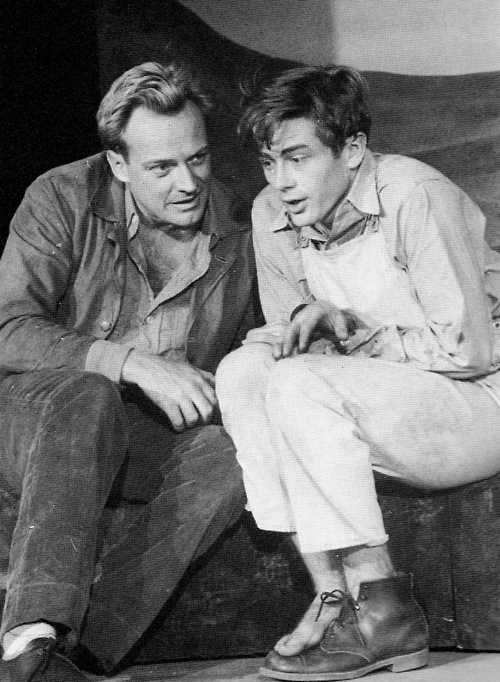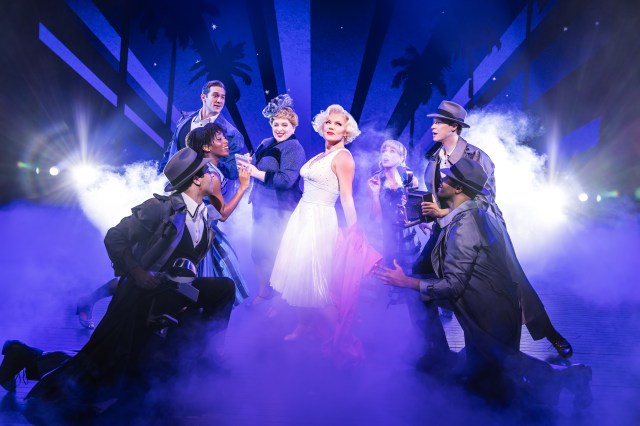Remembering James Dean: From Method Actor to Screen Idol
TheaterMania looks back at a great actor’s “exceptional imagination” and the New York mecca where he honed it: the Actor’s Studio.

(© Warner Bros.)
"Dream what you want to dream, go where you want to go, be what you want to be," James Dean has been quoted as saying. "Because you have only one life and one chance to do all the things you want to do." Another time, he stated, "The only success, the only greatness is immortality."
By that standard, Dean has achieved immortality. Long after his untimely death in 1955, the fascination with Dean lives on. On February 8, the forever young Dean would have turned 83.
Most tend to think Dean made only three films: Elia Kazan's production of Steinbeck's East of Eden, Nicholas Ray's Rebel Without a Cause, and George Steven's production of Edna Ferber's Giant — all shot within 18 months from 1954-1955. But he'd long been paying his dues — acting in college, changing his major from pre-law to drama before eventually dropping out, doing readings and workshops, working countless jobs, and acting in commercials until he finally got a break.
In 1952, while Dean was in New York, he worked behind the scenes in TV and hung with actors at the long-gone Cromwell's drug store in Rockefeller Center. It was while hanging out with these actors that his fascination with the Actor's Studio grew, convinced it was the one place he'd fit in. Dean hung around so much that he was granted membership. Dean wrote to his widowed father in Los Angeles and to his aunt and uncle on their Indiana farm, where he spent his formative years: "It's the greatest school of the theater. It houses people like Marlon Brando, Julie Harris, Arthur Kennedy, and Mildred Dunnock." He noted that "very few get into it" and that "It is the best thing that can happen to an actor." He was one of the youngest to be accepted.

(© Actor's Studio)
Eli Wallach, who knew something of "method acting," having studied at the Neighborhood Playhouse under Sanford Meisner, said, "We knew we were in the presence of a blithe spirit, someone unique." Wallach was a member since its inception in 1947 [cofounded by Elia Kazan, later to be joined by Lee Strasberg]. They performed with Brando, Montgomery Clift, and Julie Harris, among others.
Martin Landau, who met Dean at the Actor's Studio, said, "As young actors, we walked the streets, talking about theater and wondering about our next job; reading books and discussing them; seeing plays and films; doing workshops; and being serious about the thing we loved: acting. We had an amazingly instant rapport…We were sort of a surrogate family."
Colleagues spoke of Dean's "extreme concentration and exceptional imagination," and how his Actor's Studio experience established his uniqueness, enabling him to make even minor roles his own.
It was that ability to make a smaller role his own that led to Dean's off-Broadway debut in 1953, in the short-lived The Scarecrow (seven performances) at the Theater de Lys (now the Lucille Lortel) with a large cast that included his Actor's Studio pal Wallach, Anne Jackson (Mrs. Wallach), and Tony winner Patricia Neal.
In an interview, Neal said, "Jimmy was an unknown, but was jolly good in every way — such a refreshing presence. I knew he was born to become an actor."

(© Lemuel Ayers)
Next, Dean made his Broadway debut in 1952's short-lived See the Jaguar. Then, after a stint in television, he returned to the stage in 1954, when he was cast as a "pandering North African houseboy" in The Immortalist. He appeared opposite Louis Jourdan and Geraldine Page. While Dean and Page hit it off immediately, Jourdan and the rebel clashed when Dean "ignored his blocking." The two only spoke to each other onstage. Frustrated, Dean gave notice after two weeks.
His timing was fortuitous. Back at the Actor's Studio, Kazan was casting his film East of Eden and told the screenwriter and Broadway playwright Paul Osborn that he was looking for "another Brando" to play moody, insecure Cal Trask. Osborn suggested Dean.
"It was perfect casting," confirms Wallach, who recalled Kazan's notes on Cal. "He said, 'Everything this kid does should be delightfully anarchistic, odd, original, imaginative, eccentric, full of longing, and with sudden mood alterations. He is the unexpected personified. He goes directly to the heart of the matter.' That was Jimmy."
Kazan went with his instincts. "I had this intuition about Dean. He did something that attracted me…He didn't try to butter me up. He had a real sense of himself." He saw Dean as "twisted, extremely grotesque." When Kazan and Steinbeck met to discuss the arc of the script, Steinbeck decided to shift the focus of the story to Cal. "Cal is the character [whom] the audience has got to know and understand." Though Steinbeck didn't care for Dean, he wrote Kazan that "the moody, complex young man was perfect for the part."
Actor Lois Smith, who costarred with Dean on the film, has her own complex memories of him. "He was a sweet, rustic person. [But] there was [also] this suspicious, taut, guarded young man. Both seemed always present, as if there was a thrilling tension within him. Jimmy brought a new sensibility to acting."

(© Warner Bros.)
Dean flummoxed a lot of his costars, including veteran actor Raymond Massey, who couldn't stand "his Actor's Studio mentality." Massey almost walked off the film when Dean, acting in the moment, lunged at Massey, embraced him in a bear hug, and began sobbing. The camera caught the shock on Massey's face. But Kazan knew a good thing when he saw it and kept the take.
Giant director George Stevens found Dean to be a handful, too. However, Dean's anger resulted in a unique theatricality that jumped from the screen. The director noticed that after scenes were shot, Dean stayed in the moment, sometimes moody or sulking, and would do the unexpected. He told the cinematographer, "Stay on him! Keep the camera rolling."
Despite Dean's fast success in film, several Actor's Studio colleagues hoped he would return to theater. In an interview, Actor's Studio colleague and East of Eden costar Julie Harris echoed that sentiment: "[Jimmy] was very exciting — not only enormously charismatic, but also a very intelligent, gifted actor. He had this ambition to play Hamlet. I hoped he would keep working in theater."
Giant ended up being Dean's final movie. He died in a head-on collision while speeding in his new race car after completing one of his last scenes in the film. He never did get the chance to return to theater. One wonders what extraordinary roles we could have seen this exceptionally gifted actor play. But at the very least, we can relive his brief but shining career through his films.








